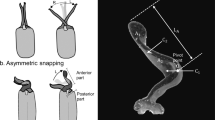Abstract
Ants of the ponerine genus Odontomachus employ a trap-jaw mechanism that allows them to instantaneously close their long, sturdy mandibles to catch prey or to defend themselves. Photoelectric scanning has revealed that these trap-jaws can be closed in less than 0.5 ms and that they decelerate before they collide with each other. The mandible strike is released in a reflexlike action when particular trigger hairs are touched. This reflex takes 4 to 10 ms and is probably the fastest reflex yet described for any animal. This speed is based on a catch mechanism in the mandible joint that keeps the extended mandibles open during contraction of the powerful closer muscle and allows the potential energy it produces to be stored within cuticular elements, apodemes, and the closer muscle itself. During a strike a relatively small specialized trigger muscle unlocks the catch, instantaneously releasing the stored energy to accelerate the mandible.
Similar content being viewed by others
References
Alexander RMcN (1988) Elastic mechanisms in animal movement. Cambridge University Press, Cambridge, pp 81–90
Alexander RMcN, Bennet-Clark HC (1977) Storage of elastic strain energy in muscle and other tissues. Nature 265: 114–117
Barth A (1960) Über den Bewegungsmechanismus der Mandibeln von Odontomachus chelifer Latr. (Hymenopt., Formicidae). An Acad Brasil Ciencias 32: 379–384
Bauer T (1982a) Prey-capture in a ground-beetle larva. Anim Behav 30: 203–208
Bauer T (1982b) Predation by a carabid beetle specialized for catching Collembola. Pedobiologia 24: 169–179
Bauer T, Pfeiffer M (1991) ‘Shooting’ springtails with a sticky rod: the flexible hunting behaviour of Stenus comma (Coleoptera; Staphylinidae) and the counter-strategies of its prey. Anim Behav 41: 819–828
Bennet-Clark HC (1975) The energetics of the jump of the locust Schistocerca gregaria. Exp Biol 63: 53–83
Bennet-Clark HC, Lucey ECA (1967) The jump of the flea: a study of the energetics and a model of the mechanism. J Exp Biol 47: 59–76
Brown WL, Wilson EO (1959) The evolution of the dacetine ants. Q Rev Biol 34: 278–294
Burrows M (1969) The mechanics and neural control of the prey capture strike in the mantid shrimps Squilla and Hemisquilla. Z Vergl Physiol 62: 361–381
Carlin NF, Gladstein DS (1989) The “bouncer” defense of Odontomachus ruginodis and other odontomachine ants (Hymenoptera: Formicidae). Psyche 96: 1–19
Christian E (1979) The jump of the Collembola. Zool Jb Physiol 83: 457–490
Corbet PS, Lonfield C, Moore NW (1960) Dragonflies. Collins, London
Dejean A (1986) Etude du comportement de predation dans le genre Strumigenys (Formicidae — Myrmicinae). Insectes Soc 33: 388–405
Dejean A, Bashingwa E (1985) La prédation chez Odontomachus troglodytes Santschi (Formicidae — Ponerinae). Insectes Soc 32: 23–42
Erber J, Schildberger K (1980) Conditioning of an antennal reflex to visual stimuli in bees (Apis mellifera). J Comp Physiol 135: 217–225
Evans MEG (1972) The jump of the click beetle (Coleoptera, Elateridae): a preliminary study. J Zool Lond 167: 319–336
Evans MEG (1973) The jump of the click beetle (Coleoptera: Elateridae): energetics and mechanics. J Zool Lond 169: 181–194
Gronenberg (1995) The fast mandible strike of the trap-jaw ant Odontomachus: II Motor control. J Comp Physiol A 176: 399–408
Gronenberg W, Tautz J (1994) The sensory basis for the trap-jaw mechanism in the ant Odontomachus bauri. J Comp Physiol 174: 49–60
Gronenberg W, Tautz J, Hölldobler B (1993) Fast trap jaws and giant neurons in the ant Odontomachus. Science 262: 561–563
Heitler WJ (1974) The locust jump: specialisations of the metathoracic femoral-tibial joint. J Comp Physiol 89: 93–104
Hölldobler B, Wilson EO (1990) The ants. Belknap Press of Cambridge University Press, Cambridge, Mass
Holstein T, Tardent P (1984) An ultrahigh-speed analysis of exocytosis: nematocyst discharge. Science 223: 830–833
Jaffe K, Marcuse M (1983) Nestmate recognition and territorial behaviour in the ant Odontomachus bauri Emery (Formicidae: Ponerinae). Insectes Soc 30: 466–481
Janet C (1905) Anatomie de la tête du Lasius niger. Limoges, Paris
Krisper G (1990) Das Sprungvermögen der Milbengattung Zetorchestes (Acarida, Oribatida). Zool Jb Anat 120: 289–312
Masuko K (1984) Studies on the predatory biology of oriental dacetine ants (Hymenoptera: Formicidae). I. Some Japanese species of Strumigenys, Pentastruma, and Epitritus, and a Malaysian Labidogenys, with special reference to hunting tactics in short-mandibulate forms. Insect Soc 31: 429–451
Moffett MW (1986) Trap-jaw predation and other observations on two species of Myrmoteras (Hymenoptera: Formicidae). Insectes Soc 33: 85–99
Wheeler WM (1900) A study on some Texan Ponerinae. Biol Bull 2: 1–31
Wheeler WM (1922) Observations on Gigantiops destructor Fabricius and other leaping ants. Biol Bull 42: 185–201
Wilson EO (1962) Behaviour of Daceton armigerum (Latr.) with a classification of self-grooming movements in ants. Bull Mus Comp Zool 127: 403–422
Author information
Authors and Affiliations
Rights and permissions
About this article
Cite this article
Gronenberg, W. The fast mandible strike in the trap-jaw ant Odontomachus . J Comp Physiol A 176, 391–398 (1995). https://doi.org/10.1007/BF00219064
Accepted:
Issue Date:
DOI: https://doi.org/10.1007/BF00219064




